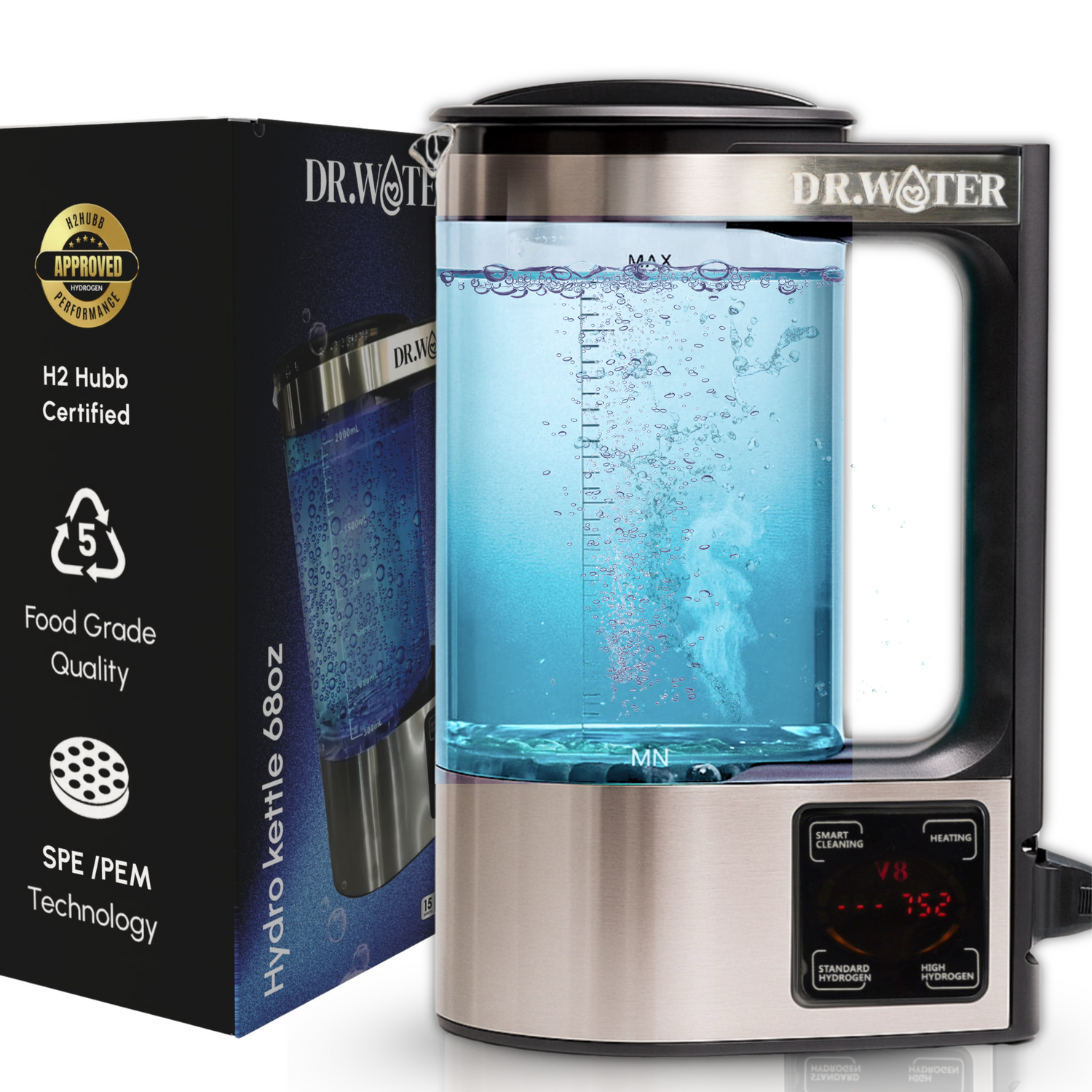
Can You Store and Reheat Water in an Electric Kettle? Everything You Need to Know
Share
Summary
|
Many of us have asked this simple question: Can you leave water in a kettle overnight or between uses? It seems harmless, just some leftover boiled water sitting in a sealed appliance. But when it comes to health, taste, and even your kettle’s long-term performance, the answer deserves a closer look.
In this guide, we break down what really happens when water is left in your electric kettle, what about reboiling water in the kettle, and how to handle your water safely. We’ve also included an alternative that makes your daily hydration cleaner and more efficient.
What Happens When You Leave Water in a Kettle?
It might seem convenient to boil water and leave the rest in the kettle. But here’s what goes on inside when water just sits there for hours or even days:
- Mineral buildup: If you use hard tap water, calcium and magnesium start forming limescale on the kettle’s heating element and walls. Over time, this can affect heating efficiency and cause damage.
- Bacterial growth: Warm, stagnant water, especially in a humid kitchen, can create a welcoming environment for bacterial colonies. While boiling can kill most bacteria, their byproducts may linger and affect taste.
- Metal corrosion: Some kettles, especially those made with mixed metals or exposed heating coils, are more prone to corrosion when exposed to water for long periods.
So next time you wonder, can you leave water in a kettle overnight? The safer answer is no, especially if you plan to drink it the next morning. Now, let’s explore whether reboiling water in a kettle is safe or not.
Does Reboiling Water Make It Unsafe?
Boiling water once purifies it, but what about boiling it again? Here's what research and chemistry suggest:
- Concentration of impurities: When you reboil water multiple times, it doesn’t just get hot again. It also allows the concentration of certain compounds to increase. This includes nitrates, fluoride, arsenic, and volatile organic compounds, depending on your water source.
- Change in taste: Repeated boiling reduces dissolved gasses like oxygen, which can make the water taste flat or metallic over time.
- Health concerns: Though not immediately dangerous in small amounts, long-term exposure to higher concentrations of these impurities may contribute to kidney strain or other chronic issues, especially in vulnerable groups.
While reboiling once or twice might not harm you, it’s a good habit to avoid reheating the same batch repeatedly. Here’s what you should do instead.
Best Practices for Storing Boiled Water
If you're not ready to part with the convenience of pre-boiled water, storing it properly is the next best thing. Here’s how to do it right:
Doing this preserves water quality and ensures you're not undoing the benefits of boiling in the first place. Now, let’s talk about how much energy goes into reheating water in an electric kettle.
The Energy Cost of Reboiling Water
Aside from the health and safety concerns, there’s also an environmental impact. Every time you reboil water that you don’t end up using, you're wasting energy. Heating water is one of the most energy-intensive tasks in households, and doing it repeatedly can lead to significant waste over time.
- Reheating can waste a lot of energy when done repeatedly. A 1,500 W kettle takes about 4 minutes to boil one liter, consuming roughly 0.1 kWh per use.
- If you reboil unused water 3 times daily, you’ll use around 9 kWh/month just on reheating . Over a year, that totals about 108 kWh.
- A typical electric kettle uses between 1,500 and 3,000 watts per use. That’s a lot of power just to keep water warm or to reheat the same volume over and over.
If sustainability is a concern, this is another reason to stop the cycle of reheating and switch to smarter storage or filtration options. Now, let’s discuss how you can determine when your kettle needs a deep clean.
Signs Your Kettle Needs a Deep Clean
Even if you’re careful, regular use will still lead to some wear and tear. Here are signs your kettle needs more than just a quick rinse:
- A chalky white residue forms inside
- Discoloration or staining near the heating element
- Strange smells when boiling
- Longer boiling times than usual
A monthly deep clean using vinegar or citric acid can help keep your kettle in top condition. Now, let’s figure out if it is safe to drink water from the kettle that has been left out overnight.
Is It Safe to Drink Water That’s Been Left Overnight?
Sometimes you might forget to empty the kettle. So, what if the water has only been left overnight? In general, if water has been sitting for more than a few hours in a non-refrigerated, open kettle, it’s safer to discard it. Here’s what you should keep in mind:
- Microbial growth is still possible. Even within 12–24 hours, especially in a humid or warm environment, bacteria can start to multiply.
- Limescale might have started forming. The longer hard water sits, the more likely minerals are to settle.
- Taste degradation is immediate. Without dissolved oxygen, the water can taste stale or flat.
It’s good to be on the safer side and avoid water that’s out in the open for more than a few hours. Now, let’s compare and discuss some popular materials for electric kettles.
Can You Leave Water in a Stainless Steel or Glass Kettle?
The type of kettle you use does make a difference. This overview can help you to choose what material is the best according to your usage habits and preference. Here’s how different materials behave:
|
Kettle Type |
Pros |
Cons |
|
Stainless Steel |
Resists corrosion, good heat retention |
May still accumulate scale, especially around seams |
|
Glass |
Non-reactive, lets you see the buildup |
Breakable, can get cloudy with mineral deposits |
|
Plastic |
Lightweight and affordable |
May leach chemicals, especially when hot |
Even with higher-end materials, it’s best not to leave water sitting overnight. Clean materials help, but time and temperature still allow bacteria or minerals to do their work.
A Safer Alternative: The Dr. Water HydroPitcher
If you're looking to skip the whole debate around you can leave water in a kettle, consider a solution that avoids boiling altogether. The Dr. Water HydroPitcher is designed to purify and enrich your water without extreme heat.
What Makes It Different?
- Hydrogen Infusion: Instead of reboiling, the pitcher gently heats water and adds molecular hydrogen, known for its top antioxidant properties.
- Advanced Filtration: Removes chlorine, lead, heavy metals, and other common tap water contaminants.
- Self-cleaning and dishwasher safe: It has a self-cleaning mode to ensure optimal electrode health, which prevents limescale buildup and makes the maintenance easy.
- Premium Build: BPA-free, made with stainless steel and borosilicate glass for durability and hygiene.
By removing the need to ask can you leave water in a kettle, the HydroPitcher gives you consistent quality without the risks of stagnation or scale buildup. Now, let’s look at some tips on how you can clean your electric kettle.
How Often Should You Clean Your Electric Kettle?
If you still prefer the traditional electric kettle, that’s okay, but maintenance becomes even more important. Here are science-backed tips:
- Empty After Every Use: Leaving water behind speeds up scale formation and bacteria buildup, which can affect kettle performance and water quality.
- Wipe Dry: Drying the inside of the kettle after use helps prevent corrosion, especially in metal kettles.
- Descale Weekly: Use a solution of equal parts water and white vinegar, boil once, let sit, and rinse thoroughly.
- Use Filtered or Distilled Water: This reduces the mineral load and makes cleaning less frequent.
These steps extend your kettle’s life and improve the safety and flavor of the water inside.
Conclusion
So, can you leave water in a kettle? Technically, yes. But for cleaner taste, better appliance hygiene, and lower health risk, it’s better not to. Whether you choose to empty and clean regularly, or switch to a self-cleaning option like the HydroPitcher, the goal is the same. You want safer hydration without unnecessary health or maintenance concerns.
You might not notice the effects of leftover water right away, but the small choices you make daily can shape long-term outcomes. It's the same for hydrogen water, it can leave a really positive impact on your health with consistent use. Try it today!
FAQs
Q: Does reheating water in an electric kettle increase the risk of overheating or damaging the kettle?
A: Reheating water in an electric kettle does not typically risk overheating or damaging the appliance, as long as the kettle has an automatic shut-off feature. However, frequent reheating, especially with very small amounts of water, may strain the heating element over time and reduce the kettle's lifespan.
Q: Does reheating water in an electric kettle consume more energy than boiling fresh water?
A: Reheating water in an electric kettle typically consumes less energy than boiling fresh water from cold. Since the water is already warm, the kettle will use less energy to bring it back to a boil. However, if the water has cooled significantly, the energy savings may not be as significant, depending on the initial temperature.
Q: Does the type of electric kettle affect how efficiently it reheats water?
A: Yes, the type of electric kettle can impact how efficiently it reheats water. Kettles with advanced features like temperature control or boil-dry protection can prevent overheating and conserve energy. Models with stainless steel or glass interiors also tend to retain heat better, improving reheating efficiency.

